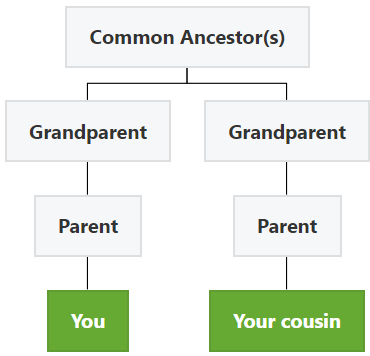The genealogical term ‘second cousin’ often leads to confusion when tracing familial connections. What is the meaning of second cousin? This article aims to dispel this uncertainty by detailing how second cousins are related, explaining shared bloodlines, and exploring their common ancestry.
We’ll also decode terms like ‘once removed’ and ‘twice removed’, along with the concept of ‘half-second cousins’. Our FAQ section will tie up loose ends, enabling you to confidently discern these complex relationships in your own family tree.
What is a Second Cousin?
A second cousin is the offspring of your parents’ first cousins, connecting you both through your shared great-grandparents. This common lineage implies that you and your second cousins share an identical genetic heritage to some extent. Specifically, you’re likely to share approximately 3.125% of your DNA with your second cousins, highlighting the genetic bond you share due to your shared ancestry.
Pro tip: Now that you understand second cousins, why not explore your family’s unique story? Try MyHeritage’s 14-day free trial to delve into billions of records and uncover your family’s tale. What stories await in your family tree?
How Is a Second Cousin Related To Me?
Based on the above second cousin definition, two-second cousins share one set of great grandparents. They are the same generation as you. To reiterate, first cousins share a grandparent and second cousins share a great-grandparent. This diagram shows how second cousins work:

What Is An Example Of a Second Cousin?
An example of second cousins is that your ancestor in common is your cousin’s great-grandparent as well. So, if your great-great-grandparent is your cousin’s great-grandparent, then you are four generations removed, and the cousin in question is removed by 3 generations from the same ancestor.
Are second cousins considered family?
Yes, second cousins are considered to be family. Unlike other relations with more generational gaps and fewer ancestors in common, second cousins are not considered to be distant relatives.
In the US, a second cousin marriage is legal. It is illegal to marry your first cousin in around half the states in the US due to genetic concerns.
As the children of first cousins, second cousins are blood-related. Second cousins share great-grandparents and as first cousins share grandparents, the connection is halved with every new generation.
First cousins share a grandparent, second cousins share a great-grandparent, and third cousins share a great-great-grandparent. The cousinhood degree of first, second, third, etc indicted the number of generations between the parents of two cousins.
How many second cousins do I have?
The average person has around 28 second cousins. Some people have more, but this is about right for most. Of course, the number varies depending on the family and how many children the great-grandparent had.
Sadly, not every child survives to adulthood and has offspring of their own, so many factors can impact the number of second cousins anyone has.
What does second cousin once removed mean?
Cousins that are not in the same generation are likely to be once removed. This is the same for second cousins. The child of a second cousin is known as a second cousin once removed.
To put this into perspective, you are the second cousin once removed to the second cousins of your parents. The common ancestor you have is your great-great-grandparent. This means you are second cousins, but with one generation between you. This makes you second cousins, once removed.
To count the number of times you are removed from a cousin, count the number of generations between you.
What does second cousin twice removed mean?
For a relative to be “removed,” cousins cannot share a generation. This means a second cousin that is twice removed is a cousin that is two generations away from another, either older or younger.
Cousins that are not removed mean they are part of your grandparent’s side but twice removed. Therefore, cousins that are in your grandparent’s generation, or the same generation as your grandchildren are removed by two generations.
What is a half-second cousin?
It is common for someone to have multiple half-cousins, namely because of the different ways such a situation can occur. You can have half first, second, third, fourth, fifth cousins, and so on.
Generally, half cousins share around half the DNA of full cousins. If you only have one ancestor in common from your great-grandparents, then you are known as half-second cousins. Half cousins occur when one member of the family remarries and has children with another person. One grandparent can have offspring with two different people, making the offspring half-siblings, and half cousins.
FAQ
What is the difference between a 1st cousin and a 2nd cousin?
A first cousin is someone who shares a grandparent and a second cousin is someone who shares a great-grandparent. So, first cousins are the children of siblings.
First cousin once removed vs second cousin: What’s the difference?
A second cousin is someone who shares at least one great-grandparent. A first cousin once removed is someone separated by a generation. A first cousin is the same generation as you, but a first cousin once removed is either your parent’s first cousin or the child of your first cousin.
Is once removed the same as a second cousin?
No, a once-removed cousin is someone who is a generation above or below another. To put it simpler – your mothers’ first cousin is your first cousin, but she is once removed because of the generation between you.
Second cousins are in the same generation, but when moving into different generations, this becomes once removed, and twice removed when you are separated by two generations. Your mother’s first cousin’s offspring will be your second cousin, but your second cousin once removed is your second cousin’s child or the parent of your second cousin.
Learn more about cousinhood and kinship.


My god-brothers and sisters are not blood related to me, but I am close with him, and we have known each other forever. Is that the same life as a cousin?
No.
Hi please could you clear this up for me,
I had a DNA genealogy done and my mums brothers daughter also had one and a it says she’s my second cousin ? How can that be possible if it’s my mums brothers daughter ?
Could be a few things going on. How many centimorgans is the match? Technically there is some overlap between 1st and 2nd cousins depending on how much dna is shared.
So if my mom’s mother’s brother had a child and my mother had me. And we are only 3 years apart what does that make us..I’m confused.please help.
Hey Nikki. In that case your common ancestor would be your great-grandparents, which would be your cousin’s grandparents (they would be one gen closer). That would make you first cousin, once removed. The years between you don’t matter, it’s the generation count that matters. Hope this helps.
Please could you clear something up. From what you said;
– if my mums 1st cousins children are my second cousins
– is my mums 1st cousin, my 1st cousin once removed or is she my second cousin once removed.
*my mum and her cousin share grandparents
Your mom’s first cousin is your first cousin once removed.
hi marc why is it that so many get confused about first cousins once removed and second cousins its not really that hard to understand